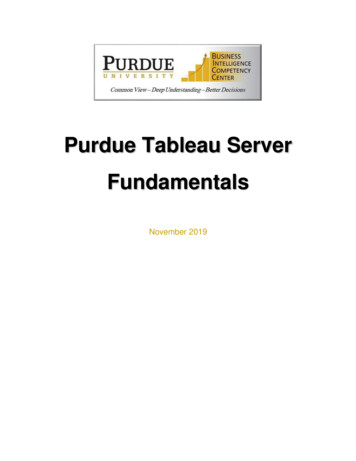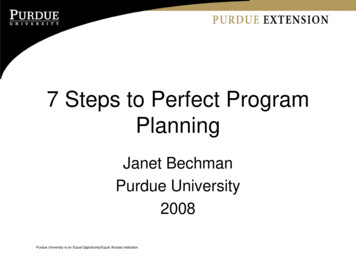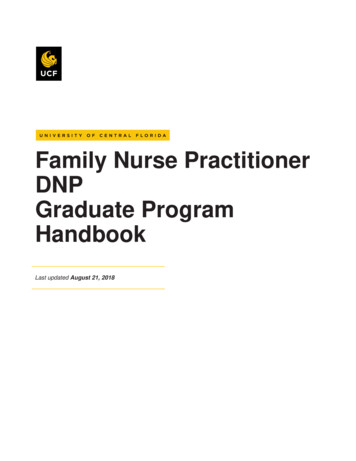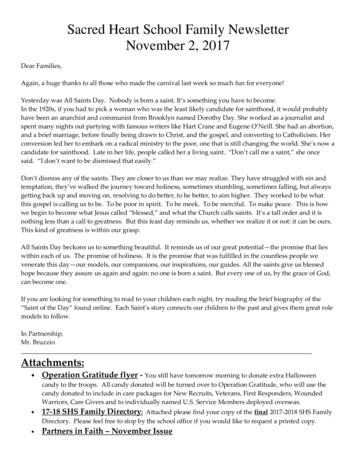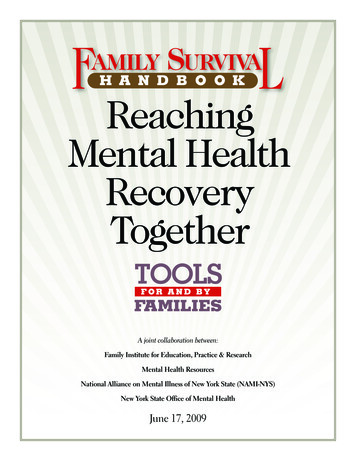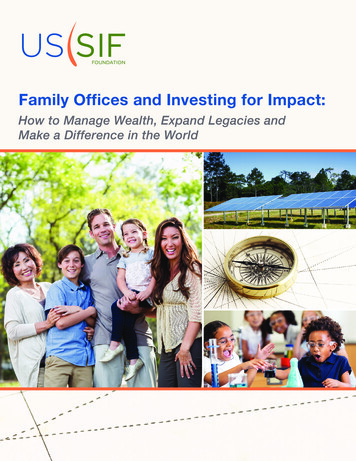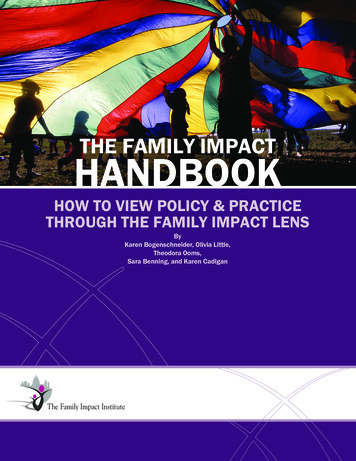
Transcription
THE FAMILY IMPACTHANDBOOKHOW TO VIEW POLICY & PRACTICETHROUGH THE FAMILY IMPACT LENSByKaren Bogenschneider, Olivia Little,Theodora Ooms,Sara Benning, and Karen CadiganThe Family Impact Institute
Family Impact InstituteNancy Nicholas Hall1300 Linden Drive, Room 4109Madison, WI 53706This report was written by an ad hoc work group of the Family Impact Institute.Members of the work group acknowledge the earlier work of the Family Impact Seminar on thistopic, and have drawn on several of its publications in the preparation of this report.The Family Impact Institute gratefully acknowledges the contributions provided by the Universityof Wisconsin-Extension, Cooperative Extension, particularly the support of Laurie Boyce, AssistantDean/Director of Cooperative Extension and State Program Director of Family Living Programs.The Institute also appreciates the contributions of the University of Wisconsin-Madison, particularlythat of Robin Douthitt, Dean of the School of Human Ecology. The Institute is sincerely grateful toall those who have funded this work between 1999 and the time of the writing of this report: the W.K. Kellogg Foundation, the David and Lucile Packard Foundation, the William T. Grant Foundation,and the Annie E. Casey Foundation.The Family Impact Institute welcomes reactions to this report from readers in order to help usprepare a revised edition. Please send your comments on how useful you find it and how it can beimproved to Karen Bogenschneider, Director, Family Impact Institute, Nancy Nicholas Hall, 1300Linden Drive, Room 4109, Madison, WI 53706. You can also email kpbogens@wisc.edu.Copyright, 2012, The Family Impact Institute, Nancy Nicholas Hall, 1300 Linden Drive, Room4109, Madison, WI 53706. All rights reserved. Requests to reprint can be sent to the email or postaladdress above.Cover photo by Jeff Miller/UW-Madison.Visit the Family Impact Institute website athttp://www.familyimpactseminars.org
THE FAMILY IMPACTHANDBOOKHOW TO VIEW POLICY & PRACTICETHROUGH THE FAMILY IMPACT LENSbyKaren Bogenschneider and Olivia LittleFamily Impact InstituteWisconsin Family Impact SeminarsUniversity of Wisconsin-MadisonUniversity of Wisconsin-Extension/Cooperative ExtensionTheodora OomsNational Healthy Marriage Resource CenterSara Benning and Karen CadiganChildren, Youth & Family ConsortiumUniversity of Minnesota
CONTENTSINTRODUCTION. 1HOW CAN I APPLY THE FAMILY IMPACT LENS?. 3The Family Impact Principles. 3Figure 1: The family impact lens in policy and practice.4Principle 1: Family responsibility . 5Principle 2: Family stability . 5Principle 3: Family relationships . 6Principle 4: Family diversity. 6Principle 5: Family engagement . 7The Family Impact Discussion Starters. 7Key tool #1: Family impact discussion starters.8The General Family Impact Checklist. 8Additional Family Impact Checklists. 8Key tool #2: Family impact checklist (with references).9Different Methods for a Single Purpose. 13Using the Family Impact Discussion Starters. 14Using the Family Impact Checklists to Guide Policy and ProgramDesign and Evaluation. 14Conducting Family Impact Analysis. 16How to use family impact analysis to review rules, legislation,laws, or programs. 17How to use family impact analysis to evaluate the culture,policies, and practices of agencies or organizations. 17Key procedure #1: Conducting a family impact analysisof rules, legislation, laws, or programs.21Key procedure #2: Conducting a family impact analysisof an organization using a quantitative checklistsupplemented with discussion by a group of stakeholders.22P.ii
Key procedure #3: 10 tips for conducting family impact analysis.24What is Realistic and Unrealistic to Expect from Family Impact Analysis?. 25WHAT TOOLS AND EXAMPLES ARE AVAILABLE?. 27Family Impact Toolkit Index: Where to Find Key Definitions,Key Tools, and Examples. 27Additional Resources. 28Key Tool #1: Family Impact Discussion Starters. 30Key Tool #2: Family Impact Checklist (without references). 31Key Tool #3: Family Functions and Roles. 35Key Tool #4: Family Functions Shared with Social Institutions. 36Key Tool #5: Family Diversity and Contexts. 37Key Tool #6: Policy and Program Implementation. 38REFERENCES. 39THE FAMILY IMPACT HANDBOOK: HOW TO VIEW POLICY & PRACTICE THROUGH THE FAMILY IMPACT LENSP.iii
INTRODUCTIONMost policymakers would not think of passing a law without first asking, “What’sthe economic impact?” The family impact lens encourages policymakers andprofessionals to routinely ask a similar question, “What is the impact of this policy,program, or practice for families?” When economic questions arise, it is almostaxiomatic to consult economists for economic data and research to assess the impactof the proposed action on selected aspects of the economy. Similarly, when familyquestions arise, policymakers and professionals should turn to family scientists forfamily data and research upon which to base an assessment of the effects of theproposed action on family roles, structure, and functioning.The conundrum we face is this: How can we encourage policymakers andprofessionals to view policy and practice through the family impact lens rather thanthrough the lens of individuals in the family? We detail in the companion paper,the Family Impact Rationale, how we can act on the growing body of evidencethat families should be an explicit criterion for making decisions. What tools, tips,and examples are available to operationalize family support and, in so doing, placefamilies front and center in how we do policy and practice?The family impactlens encouragespolicymakers andprofessionals toroutinely ask,What is theimpact of thispolicy, program,or practice forfamilies?“”Photo courtesy of Jeff Miller/UW-Madison.THE FAMILY IMPACT HANDBOOK: HOW TO VIEW POLICY & PRACTICE THROUGH THE FAMILY IMPACT LENSP.1
Approachingpolicy andpractice throughthe family impactlens has thepotential tostrengthen andsupport familiesin all theirdiversity acrossthe lifespan.This handbook begins to address this conundrum. Approaching policy and practicethrough the family impact lens has the potential to strengthen and support families inall their diversity across the lifespan. The Family Impact Handbook provides: The family principles that evidence suggests are fundamental to assessingpolicies and programs for their support of family well-being; Processes and procedures for raising the family impact discussion starters, forusing the family impact checklists, and for conducting family impact analysis; Case studies that apply the family impact lens using different methodologies invaried settings; Tools and tips for conducting family impact analysis along with appropriatecautions; and Current examples of how family impact analysis has been used to assessparticular policies and programs.P.2INTRODUCTION
HOW CAN I APPLY THEFAMILY IMPACT LENS?We discuss here how to view policy and practicethrough the family impact lens. The family impactlens can provide a wide-angle view of family supportor a narrow focus on a particular policy or program.Infusing the family impact lens into policy andpractice can take a number of different forms. Fivebasic principles serve as the core of the family impactlens, whether operationalized as Family ImpactDiscussion Starters, Family Impact Checklists, orFamily Impact Analysis. In Figure 1 (next page),we organize these three methods from the least timeconsuming (i.e., family impact discussion starters) tothe most time- and resource-intensive (a full familyimpact analysis); using the family impact checklistmethod falls in between in terms of required time andresources. Each method uses different procedures forthe singular purpose of developing policies and programs that strengthen and supportdiverse families across the lifespan. The methodologies vary according to the targetaudience, the intended use, and the available time and resources. (These methods areadapted and expanded from the earlier work of Ooms and Preister, 1988 and Gross,Bogenschneider, and Johnson, 2006.)We begin by introducing and providing the evidence base for the Family ImpactPrinciples followed by a detailed description of how each of the three methods bringsthe family impact lens to policies and programs. Figure 1 displays these three methodsand details the resources in the Family Impact Toolkit—the two key definitions, thethree key procedures, and the six key tools found in this Handbook.Photo courtesy of Stephanie Eddy.A family impactlens can providea wide-angleview of familysupport or anarrow focus on aparticular policyor program.THE FAMILY IMPACT PRINCIPLESBased on a review of the latest research, we revised the family impact principlesfrom those originally proposed (see Ooms & Preister, 1988). These evidence-basedprinciples raise family-sensitive and policy-relevant considerations that can helpstrengthen family functioning. Analyzing issues through the family impact lens firstinvolves an awareness of the many different types of families and the ways changesin family life reverberate through the major institutions of society. Family life in theU.S. today is marked by a kaleidoscope of racial/ethnic diversity, decreases in fertility,increases in life expectancy, changes in sequencing of marriage and childbearing, arapid rise in maternal employment, an escalation in rates of cohabitation and divorce,a prolonged transition to young adulthood, etc. (e.g., Cherlin, 2010; Walsh, 2003).THE FAMILY IMPACT HANDBOOK: HOW TO VIEW POLICY & PRACTICE THROUGH THE FAMILY IMPACT LENSp.3
Figure 1. The Family Impact Lens in Policy and PracticeFAMILY IMPACT PRINCIPLES- Family Responsibility- Family Stability- Family Relationships- Family Diversity- Family EngagementFAMILY IMPACTDISCUSSION STARTERSPrepare questionsor testimonyfor hearings,meetings, andpublic forumsFrame policydiscussions onbroad socialproblems orgenerate policyresponses bypanels, boards, orcommissionsFAMILY IMPACTANALYSISFAMILY IMPACTCHECKLISTGuide programand policydesignGuide programand policyevaluationPOLICIES AND PROGRAMSTHAT STRENGTHEN FAMILIESReview rules,legislation, laws,or programs topoint out how wellthey do or do notsupport familywell-beingExamine theculture, policies,and practicesof agencies andorganizations todetermine howfamily-centeredthey areLowHighLevel of Time and Resources RequiredFAMILY IMPACT TOOLKITp.4Key DefinitionsKey ProceduresKey Tools- What is Policy, Family Policy, andthe Family Impact Lens in Policyand Practice?- Conducting a Family ImpactAnalysis of Rules, Legislation,Laws, or Programs- Family Impact Discussion Starters- What is a Family?- Conducting a Family ImpactAnalysis of an Agency orOrganization- Family Functions and Roles- Tips for Conducting FamilyImpact Analysis- Family Diversity and ContextsHOW CAN I APPLY THE FAMILY IMPACT LENS?- Family Impact Checklist- Family Functions Sharedwith Social Institutions- Policy and ProgramImplementation
Thus, in beginning the process of applying the family impact lens, we stress theimportance of first identifying which types of families may be impacted by the policy,program, or practice. Considerations should include different family structures andarrangements, including those who function as a family even if they are not legallyrecognized as such; families from different cultural, ethnic, racial, and religiousbackgrounds, geographic locations, and socioeconomic statuses; families withmembers who have special needs; families of different structures; and families atdifferent stages of the life cycle (Moore, Chalk, Vandivere, & Scarpa, 2003; Olson &Gorall, 2003; Walsh, 2003).Next, the following five principles can be used to carefully consider the intended andunintended effects of policies, programs, or practices on various family types. Notethat the principles apply the family impact lens to policies or programs (i.e., whatpolicies or programs are enacted or established) and also to practices (i.e., how policiesor programs are implemented). Keep in mind that not every principle will apply toevery issue. The principles are not rank-ordered, and sometimes they may conflict withone another. Depending on the issue, one principle may be more highly valued thananother, requiring trade-offs. Cost-effectiveness and political feasibility must also betaken into account. Despite these complexities, the principles have proven useful acrossthe political spectrum and have the potential to build broad, bipartisan consensus. Principle 1: Family responsibility. To promote family well-being and selfsufficiency, policy and practice should be aimed at supporting the functions offamilies—family formation, partner relationships, economic support, childrearing,and caregiving (Bogenschneider, Little, Ooms, Benning, Cadigan, & Corbett,2012)—rather than unnecessarily supplanting the family’s role (Krysan, Moore, &Zill, 1990b; Walsh, 2002, 2003). Policy and practice can help families build theircapacity to fulfill these functions and avoid taking over these responsibilities unlessabsolutely necessary (Berlin, 2007, 2008; Conger, Conger, & Martin, 2010; Hawkins& Ooms, 2012; National Human Services Assembly, 2009; Olds et al., 1997;Olds et al., 1998). For those caring for dependent, seriously ill, or disabled familymembers, expectations need to be realistic taking into account family structure,resources, and life challenges (Patterson, 2002; Walsh, 2002). Policy and practiceshould strive to address root causes of financial responsibility and recognizefamily members’ need to balance work, family, and community commitments(Black & Lobo, 2008; Center for the Study of Social Policy, 2008; Crosnoe &Cavanaugh, 2010; Daly, 2001; Fraenkel, 2003; Hawkins & Ooms, 2012).To promote familywell-being andself-sufficiency,policy and practiceshould be aimedat supportingthe functions offamily rather thansupplanting them. Principle 2: Family stability. Family instability exposes children to an arrayof negative developmental outcomes, disadvantages adults emotionally andeconomically, and contributes to growing disparities of income and opportunity(Hawkins & Ooms, 2012). Policy and practice should reinforce healthy couple,marital, parental, and family commitments (Knox, Cowan, Pape Cowan, & Bildner,2011), recognizing that major family changes or transitions, such as aging, adoption,or divorce may be extended processes that require ongoing support and attentionTHE FAMILY IMPACT HANDBOOK: HOW TO VIEW POLICY & PRACTICE THROUGH THE FAMILY IMPACT LENSp.5
(Gabovitch & Curtin, 2009; Leadbeater, Schellenbach, Maton, & Dodgen, 2004;Olson & Gorall, 2003). Incorporating prevention strategies can avert crises andchronic situations that can threaten family structure and functioning (Center for theStudy of Social Policy, 2008; Patterson, 2002; Small, Cooney, & O’Connor, 2009).Policy andpractice shouldacknowledgethat family ties,whether positiveor negative, arepowerful andpersistent.Photo courtesy of Cassandra Musser.p.6 Principle 3: Family relationships. Policy and practice should acknowledgethat family ties, whether positive or negative, are powerful and persistent (Conger etal., 2010; Knox et al., 2011; Moore et al., 2003). In healthy relationships, individualsare able to recognize and balance family members’ needs for separateness andtogetherness (Moore et al., 2003; Olson & Gorall, 2003). Healthy familiesare able to maintain stability, while accommodating needed change throughpositive relationships (Olson & Gorall, 2003). Research demonstrates that strongcommunication skills, conflict resolution strategies, parenting skills, and problemsolving abilities are essential mechanisms for fostering family competence andresilience (Krysan, Moore, & Zill, 1990a; Miller, Ryan, Keitner, Bishop, & Epstein,2000; Moore et al., 2003; Olson & Gorall, 2003; Patterson, 2002; Walsh, 2002). Principle 4: Family diversity. Family functioning is influenced by an arrayof contextual factors including culture, family structure, geographic locale,life stage, race/ethnicity, religion, socioeconomic status, and special needs(Leadbeater et al., 2004; Moore et al., 2003). Well-documented disparitiespersist in education, employment, health status, and related outcomes amongdifferent racial/ethnic, socioeconomic, and other marginalized groups; suchgroups continue to be over-represented in high-risk populations (Burton,Bonilla-Silva, Ray, Buckelew,& Freeman, 2010; Olavarria,Beaulac, Belanger, Young, &Aubry, 2009). Policies andpractices can have variedeffects on diverse families, andshould examine whether theirpractices create or contributeto inequitable outcomes.They should acknowledgeand attempt to disentanglesome of the complexities ofwhere disparities occur andwhy (M. Cancian, personalcommunication, February 24,2011). Racial disparities inhealth outcomes, for example,could stem from a number offactors including biologicaldifferences; cultural practices;HOW CAN I APPLY THE FAMILY IMPACT LENS?
racial discrimination in the healthcare system; institutional barriersin the community such as limitedaccess to health care or substandardhousing; or some combinationthereof (e.g., Williams & Jackson,2005). These factors can affectfamily processes, financialstability, resource availability, andcommunity connections, all ofwhich can influence individual andfamily development (Garcia Coll,2001; McGoldrick, 2003). Principle 5: Familyengagement. Family-centeredapproaches need to be systematicallyidentified, verified, and incorporated into organizational philosophy, culture, andpractice. For example, relational practices (e.g., communicating in ways that treatfamilies with dignity and respect) and participatory practices (e.g., involvingfamilies in ways that provide choices and input into decisions) have been showto strengthen self-efficacy, which can directly and indirectly improve familyfunctioning (Dunst, Trivette, & Hamby, 2007). Policy and practice can connectfamilies to resources such as friends; family-to-family supports; and community,neighborhood, volunteer, and faith-based organizations (Black & Lobo, 2008;Boyd-Franklin, 2003; Hawkins & Ooms, 2012). Policy and practice should striveto incorporate family voices (Walsh, 2002), particularly those of marginalizedfamilies, who often are disconnected from political and planning processes andoften labeled “hard-to-reach” (Greder, Brotherson, & Garasky, 2004; Winton &Crais, 1996). When family members are involved in reinforcing, supplementing,and sustaining the efforts of educators, health care professionals, and socialworkers, such efforts are more successful (Dunst et al., 2007).Photo courtesy of Janean Dilworth-Bart.Policy andpracticeshould striveto incorporatefamily voices,particularly thoseof marginalizedfamilies, whooften aredisconnectedfrom politicaland planningprocesses.THE FAMILY IMPACT DISCUSSION STARTERSThe family impact discussion starters parallel the family impact principles (Key Tool#1). These discussion starters can serve to build awareness. They can also providean organizing framework for thinking about how policies, programs, agencies, ororganizations may have intended and unintended consequences for family wellbeing. Asking about family impact when policies are being developed, implemented,or evaluated can bring a unique perspective to policy debates or program goals byunderscoring the importance of families as institutions that foster commitment toothers. Not every discussion starter may be relevant for every issue and purpose.THE FAMILY IMPACT HANDBOOK: HOW TO VIEW POLICY & PRACTICE THROUGH THE FAMILY IMPACT LENSp.7
KEY TOOL #1FAMILY IMPACT DISCUSSION STARTERSHow will the policy, program, or practice: support rather than substitute for family members’ responsibilities to one another? reinforce family members’ commitment to each other and to the stability of the family unit? recognize the power and persistence of family ties, and promote healthy couple, marital, andparental relationships? acknowledge and respect the diversity of family life (e.g., different cultural, ethnic, racial, andreligious backgrounds; various geographic locations and socioeconomic statuses; families withmembers who have special needs; and families at different stages of the life cycle)? engage and work in partnership with families?THE GENERAL FAMILY IMPACT CHECKLISTThe general family impact checklist that follows can be used for almost any issue anda number of purposes. Consistent with current research evidence, we have identifiedfive new family impact principles. Each family impact principle is accompanied by aseries of questions that delve more deeply into the ways in which families contributeto issues, how they are affected by them, and whether involving families would resultin more effective and efficient solutions. The checklist can be used as a stand-alonetool to help design and evaluate programs and policies, or it can be used as the basisfor a full-fledged family impact analysis. Examples of these varied purposes areprovided in the next section.ADDITIONAL FAMILY IMPACT CHECKLISTSA number of specialized checklists also are available for assessing family impacts inspecific settings (e.g., adolescent treatment centers, communities, and schools) and forparticular policies (e.g., child and family services plans, school funding formulas, andearly care and education policies). These checklists help “organize the vast, complex,and fragmented body of program information, data, and research related to familiesinto categories and factors that have special relevance for policy and programs”(Ooms, 1995, p. 8). Each item on these checklists is evidence-based. The generalidea is to acknowledge the needs of family members and involve them so they canreinforce rather than undermine the goals of the program or policy. Professionals who(Continued on page 13)p.8HOW CAN I APPLY THE FAMILY IMPACT LENS?
KEY TOOL #2THE FAMILY IMPACT CHECKLISTUSING EVIDENCE TO STRENGTHEN FAMILIES(with references)Policymakers from across the political spectrum endorse families as a sure-fire, vote-winning strategy. Researchers have demonstratedthe valuable role families play in promoting academic success, economic productivity, social competence, and so forth. Professionalswho educate or deliver services to families recognize the viability of family-centered approaches for achieving program goals.Yet family considerations are rarely addressed in the normal routines of policy and practice. Pro-family rhetoric is not enough. TheFamily Impact Checklist is one evidence-based strategy to help ensure that policies and programs are designed and evaluated inways that strengthen and support families in all their diversity across the lifespan. This checklist can also be used for conducting afamily impact analysis that examines the intended and unintended consequences of policies, programs, agencies, and organizationson family responsibility, family stability, and family relationships. Which types of families are affected? How are they helped or hurt?What steps can be taken to strengthen families’ capacity to support their members and the contributions they make to society?This brief guide provides a four-step overview of how to use a family impact checklist to conduct a family impact analysis. Moredetailed guidelines and procedures for conducting a family impact analysis are available in a handbook published by the FamilyImpact Institute at http://www.familyimpactseminars.org.USING THE CHECKLIST TO CONDUCT A FAMILY IMPACT ANALYSIS1. Select the rule, legislation, law, program, agency, or organization and decide what components will beanalyzed. Family impact analysis can be used to review rules, legislation, laws, or programs for their impact on families,and to evaluate the family focus and operating procedures of agencies and organizations. Court decisions, regulations,administrative practices, and implementation procedures can also be analyzed for their impact on family well-being. Familyimpact analysis can be a preliminary process conducted at an early stage when a policy or program is being designed, at aninterim stage when a policy or program is being implemented, or at a later stage when being evaluated or reauthorized.2. Determine which family types might be affected. Families come in many forms and configurations. In beginning theprocess, it is important to identify which types of families may be impacted by the policy, program, or practice.Which types of families does or will the policy, program, or practice affect?q particular family structures?q families in a particular stage of the life cycle?q families from particular incomes or educational levels?q families from particular cultural, geographic, racial/ethnic, or religious backgrounds?q families who have members with special needs (e.g., cognitive, emotional, physical)?q those who function as a family even if they are not legally recognized as such?(Cherlin, 2010; Leadbeater, Schellenbach, Maton, & Dodgen, 2004; Moore, Chalk, Vandivere, & Scarpa, 2003; Olson &Gorall, 2003; Walsh, 2003)3. Select a family impact checklist and conduct the analysis. Family impact analysis is most incisive andcomprehensive when it includes expertise on (a) families, (b) family impact analysis, and (c) the specifics of the policy,program, agency, or organization. Five basic principles form the core of a family impact checklist. Each principle isaccompanied by a series of evidence-based questions that delve deeply into the ways in which families contribute toissues, how they are affected by them, and whether involving families would result in better solutions. Not all principles andquestions will apply to every topic, so it is important to select those most relevant to the issue at hand.These questions sound simple, but they can be difficult to answer. The principles are not rank-ordered and sometimes theyconflict with each other. Depending on the issue, one principle may be more highly valued than another, requiring tradeoffs. Cost effectiveness and political feasibility also must be taken into account. Despite these complexities, family impactanalysis has proven useful across the political spectrum and has the potential to build broad, bipartisan consensus.4. Disseminate and apply the results. A family impact analysis seldom results in overwhelming support for or oppositionto a policy or program. Instead, implications are drawn regarding how the policy or program affects specific types of familiesand particular family functions. Disseminating the results to policymakers and the public may generate interest in and themomentum for developing policies, programs, and practices that are more responsive to and supportive of family well-being.
FAMILY IMPACT CHECKLISTPrinciple 1. Family responsibility. Policies and programs should aim to support and empower the functions thatfamilies perform for society—family formation, partner relationships, economic support, childrearing, and caregiving.Substituting for the functioning of families should come only as a last resort.How well does the policy, program, or practice:StrongAdequateLimitedN/Aqqqqhelp families build the capacity to fulfill their functions and avoid taking over familyresponsibilities unless absolutely necessary? (Conger, Conger, & Martin, 2010; NationalHuman Services Assembly, 2009; Olds et al., 1997; Olds et al., 1998; Walsh, 2002)qqqqset realistic expectations for families to assume financial and/or caregivingresponsibilities for dependent, seriously ill, or frail family members depending on theirfamily structure, resources, and life challenges? (Patterson, 2002; Walsh, 2003)qqqqaddress root causes of financial insecurity such as high child support debt, low literacy,low wages, and unemployment? (Center for the Study of Social Policy
THE FAMILY IMPACT PRINCIPLES Based on a review of the latest research, we revised the family impact principles from those originally proposed (see Ooms & Preister, 1988). These evidence-based principles raise family-sensitive and policy-relevant co

